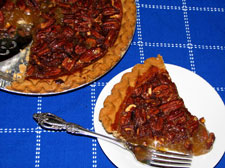Resource Library
Plant of the Week: Pecan
The University of Arkansas System Division of Agriculture does not promote, support or recommend plants featured in "Plant of the Week." Please consult your local Extension office for plants suitable for your region.
Plant of the Week
Pecan
Latin: Carya illinoensis

Every Thanksgiving, I think I’d like to have my own pecan tree. The odds of a bountiful harvest is by no means a sure thing, what with scab, pecan weevil, squirrels and crows all to contend with. But it might be worth a try.
Pecans (Carya illinoensis) are large trees capable of reaching 100 feet or more in height with a rounded crown when they reach maturity. Their native range is entirely in the Mississippi River drainage from southern Illinois to Mississippi and Louisiana. They range westward into central Oklahoma and Texas but eastward only a short distance from the river. Pecans are bottomland trees only found in areas where topsoil has accumulated to significant depth. Unlike most other hickories, they never made a home in the Ozarks or Ouachita Mountains.
The pecan’s kinship with walnuts can be seen by examining the leaves. Pecans have oddly pinnate compound leaves 12 inches to 20 inches long with 9-17 leaflets. Leaves are a lustrous green during the summer, but there is little fall color.
Male or female flowers appear in mid to late spring on the same tree. The flowers have no ornamental interest and are produced at slightly different times, so best nut set requires two different cultivars. The nuts are 1 inch to 2 inches long and, provided the pecan weevil hasn’t invaded the nut, are released from the four-sided husk in October and November.
Trees begin producing nuts around their 10th to 12th year, but it may take up to 20 years before yields become significant. On average, each tree will produce 150 pounds of nuts, but mature trees have been known to produce 500 pounds or more. Pecans are notorious alternate-bearers with full crops produced only every other year.
Hernando DeSoto and his gang of gold seekers were the first Europeans to encounter the pecan. They found it growing in present day Arkansas in 1541 after days spent slogging through the swamps that used to occupy much of the eastern part of the state. In his journals, it was called a walnut, but the description identifies it as pecan.
Jefferson was among the first to plant it in the eastern states. In the spring of 1786, Jefferson shared some seedlings with George Washington for planting at Mt. Vernon. Washington called the tree “Illinois nut.” The name pecan is an Algonquin word describing a nut that required a stone to crack and was adopted by French trappers.
My personal introduction to pecans began at the Thanksgiving table. It turns out pecan pies were first introduced in the 1930s after the wife of one of the Karo corn syrup sales executives came up with the recipe in her own kitchen. In parts of the South they’re still called “Karo nut pies.”
Pecans aren’t especially good yard trees because they are really big, they’re afflicted by all manner of insect and disease problems and they’re always dropping something you have to pick up. But, if you have room and a good deep soil, they’re worth a try. Only consider them if you have at least a couple feet of good topsoil. Pecans are notoriously difficult to transplant, so choose only small trees from the nursery.
The other problem with growing pecans is fighting back all the pests and diseases. Many people who take no measures to control the pecan weevil may only get a few nuts once every five or 10 years. Though the weevils are not especially difficult to control with well timed insecticidal sprays, it’s difficult to manage the task of effectively spraying such potentially large trees.
By: Gerald Klingaman, retired
Extension Horticulturist - Ornamentals
Extension News - December 7, 2007
The University of Arkansas System Division of Agriculture does not maintain lists of retail outlets where these plants can be purchased. Please check your local nursery or other retail outlets to ask about the availability of these plants for your growing area.